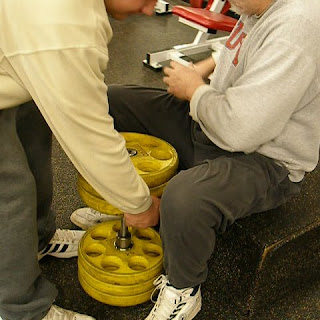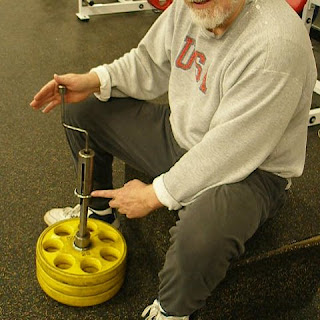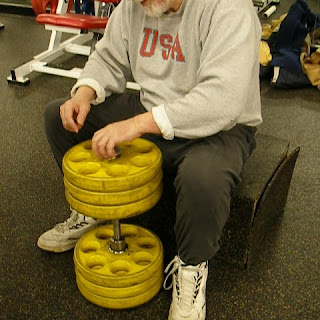This is no ordinary dumbbell. It has screw on end caps. There is a hole through the center of the dumbbell that allows the user to adjust the inside collars by means of screw threads so the barbell plates don't rattle around.
The dumbbell can be further modified by removing the handle and screwing in successively thicker handles.
You might wonder, why so much detail in a dumbbell? Two reasons.
First, the commercial gym I go to has a dumbbell rack that increases in 5-lb increments to only 125 lbs. For those of you who have seen the cover of
Diagnostic Bodybuilding, you will easily recognize that "I'm about out of weight." I can carry less than 26 lbs of equipment (MOAD) into the gym and easily load my dumbbells--using 25-lb plates--to over 200 lbs each. It's going to take me awhile to run out of weight with these.
If I use 45-lb plates, I can use over 370 lbs.
Second, I have been fascinated with the Thomas Inch Challenge Dumbbell since an article on it first appeared in Milo magazine years ago. The Inch Dumbbell weighed 172 lbs and had a 2-3/8" diameter handle. Inch offered a cash prize to any other man who could lift it even 4 to 6 inches off the ground.
Twenty thousand men tried. Twenty thousand men failed from 1900 to 1920. In the entire twentieth century fewer than two dozen men were able to lift it with
one hand. You will see various contestants at the Arnold Classic lift a replica overhead. However, they all get it to the shoulder with
both hands.
I tried training with a thick-handled dumbbell. It didn't work. If I added 2.5 lbs to it, I went from an exercise to an impossibility. There had to be another way.
Generations ago Edward Aston, at one time England's strongest man, pointed out that the way to train for lifting thick-handled weights was to increase the diameter of the bar in small increments. I could never come anywhere near the Inch Dumbbell lift with a 2-3/8" handle.
However, notice that the
first time I used the Mother of All Dumbbells, I was doing
reps with 162 lbs. As I increase the weight, I will soon pass 172 lbs. Then, when I am up over 200 lbs in the one-dumbbell deadlift, I will drop weight and use a slightly thicker handle.
I have two of these dumbbells, which had to be designed and machined. Mechanically, they are more complicated than an Olympic barbell set. They're expensive. Part of my "master plan" is to keep using one with the 1-1/8" handle and increasing the weight lifted while I increase the diameter of the other one. Of course, now I'm going to need
another set for dumbbell bench presses. Eventually, I will lift the Inch Dumbbell.
One more thing. The one-dumbbell deadlift is
the exercise for grip development. A fellow named John Y. Smith worked up to over 300 lbs in this lift and had hands that looked like iron claws (see my book by that title, available from Bill Hinbern, http://www.superstrengthbooks.com/).
 ~~~~~~~~~~~~~~~~~~~~~~~~~~~~~~~~~~~~~~~~~
~~~~~~~~~~~~~~~~~~~~~~~~~~~~~~~~~~~~~~~~~ ~~~~~~~~~~~~~~~~~~~~~~~~~~~~~~~~~~~~~~~~~
~~~~~~~~~~~~~~~~~~~~~~~~~~~~~~~~~~~~~~~~~ ~~~~~~~~~~~~~~~~~~~~~~~~~~~~~~~~~~~~~~~~~
~~~~~~~~~~~~~~~~~~~~~~~~~~~~~~~~~~~~~~~~~ ~~~~~~~~~~~~~~~~~~~~~~~~~~~~~~~~~~~~~~~~~
~~~~~~~~~~~~~~~~~~~~~~~~~~~~~~~~~~~~~~~~~ ~~~~~~~~~~~~~~~~~~~~~~~~~~~~~~~~~~~~~~~~~
~~~~~~~~~~~~~~~~~~~~~~~~~~~~~~~~~~~~~~~~~



